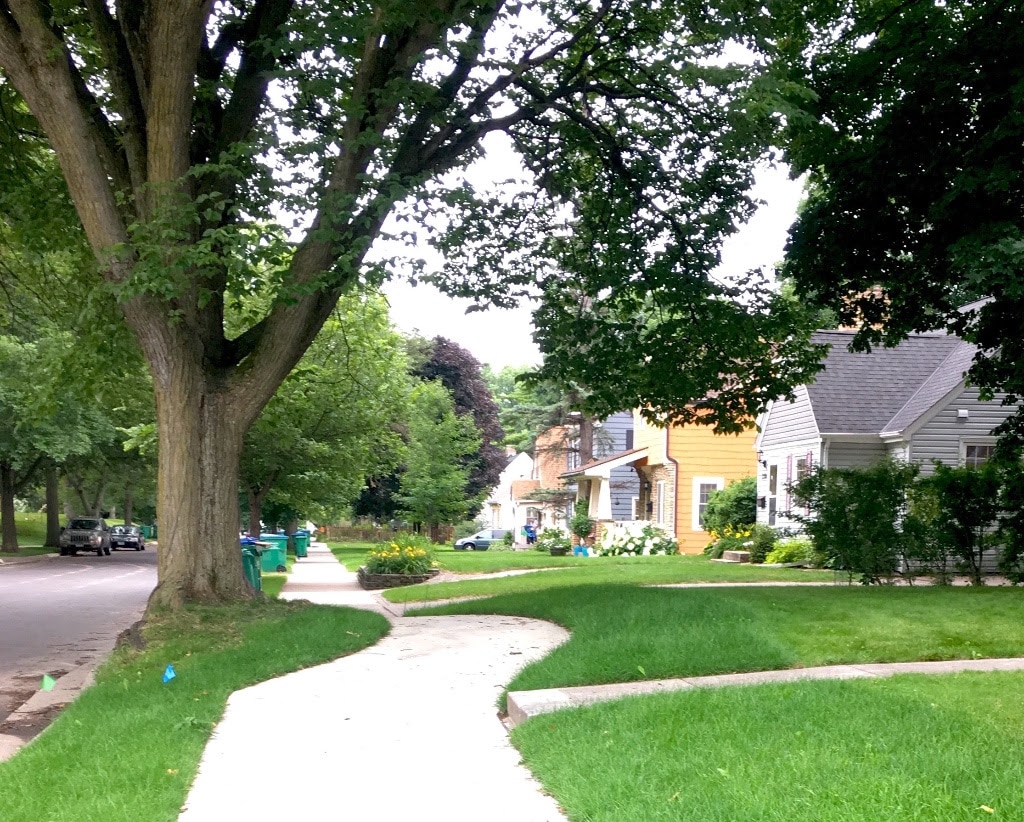|
|
|
I grew up in a first-ring suburb that was a lot like St. Louis Park. The summer I was twelve, the city removed a tree in front of our house to make room for a sidewalk. I’d spent many happy hours sitting in the branches of that tree, looking out over the world. I was sad to lose it.
Ten years ago, St. Louis Park residents and leaders agreed on a goal to make our city more walkable and bike-friendly. Connect the Park, as the project became known, began in earnest in 2015. Since then, almost five miles of new sidewalks have been added, with eight more miles to go by 2023 (click here for a map of current and future projects). This project has resulted in the removal of trees. Some homeowners have also lost a portion of what they considered their yards, although in most cases it was public right-of-way. Still, Connect the Park has clearly had an impact on green and growing things in SLP, along with some homeowners’ sense of proprietary rights. In my conversations with Ward 1 residents, most—though not all—say they’re in favor of new sidewalks. Children’s safety is the reason people cite most often. But pedestrian safety overall is a concern for many. Between distracted drivers, speeding, and visibility issues, it can be unnerving to take a stroll down the block, let alone send kids out on their own. Overall, I think our city has done a good job implementing Connect the Park. City leaders have been responsive to residents, while staying true to the goal to create a more walkable city. I’ve seen stretches of sidewalk that wind around mature trees to save them. I’ve also learned that for every tree removed, our city plants one or more that total the circumference of the lost tree. I know that sidewalk plans have been revised, and in some cases shelved entirely, in response to resident feedback. It’s worth noting that while homeowners in nearby communities are assessed for new sidewalks in front of their homes, St. Louis Park homeowners are not. Sidewalks aren’t just good for children. A recent AARP survey reveals that eight in ten Americans prefer living in a community that offers sidewalks and pleasant places to walk. Other research shows that sidewalks reduce crime, increase property values, and build social capital. Safe, accessible, and well-maintained sidewalks are indeed a community benefit. Which brings us to the topic of maintaining our sidewalks. I’ve heard St. Louis Park residents who are seniors, and residents who have physical disabilities, describe the challenge of keeping their sidewalks clear of snow in winter. Through research and further discussions, I’ve come to believe that it’s an unfair burden to require every homeowner to clear the sidewalks around their home each time it snows, or risk a fine. Reliable volunteer help can be hard to find, and professional snow removal services can cost hundreds of dollars a season. I think we’re remiss in not addressing the financial burden mandatory sidewalk snow removal places on SLP seniors and others. Currently, our city clears about 45 percent of sidewalks in winter. I believe that if making our entire community pedestrian-friendly is a priority, then finding a practical, affordable, and equitable way to keep 100 percent of our sidewalks walkable, in all seasons, should be too. What do you think? I welcome your thoughts here. In the 40 years since a sidewalk was added in front of my parents’ Roseville home, a whole lot of people have enjoyed it. The sidewalk enriched my own and my parents’ experience of living in the house. Yes, we lost a beloved tree, and a stretch of grass too, but we gained a deeper connection to, and appreciation for, the people and the community we called home. We also gained a safe and inviting place to take many relaxing walks we may otherwise not have taken. It was, in the end, a good tradeoff. I predict we’ll feel the same way here. |
Prepared and paid for by Rog for SLP City Council, 2817 Zarthan Ave. S., St Louis Park, MN 55416


 RSS Feed
RSS Feed